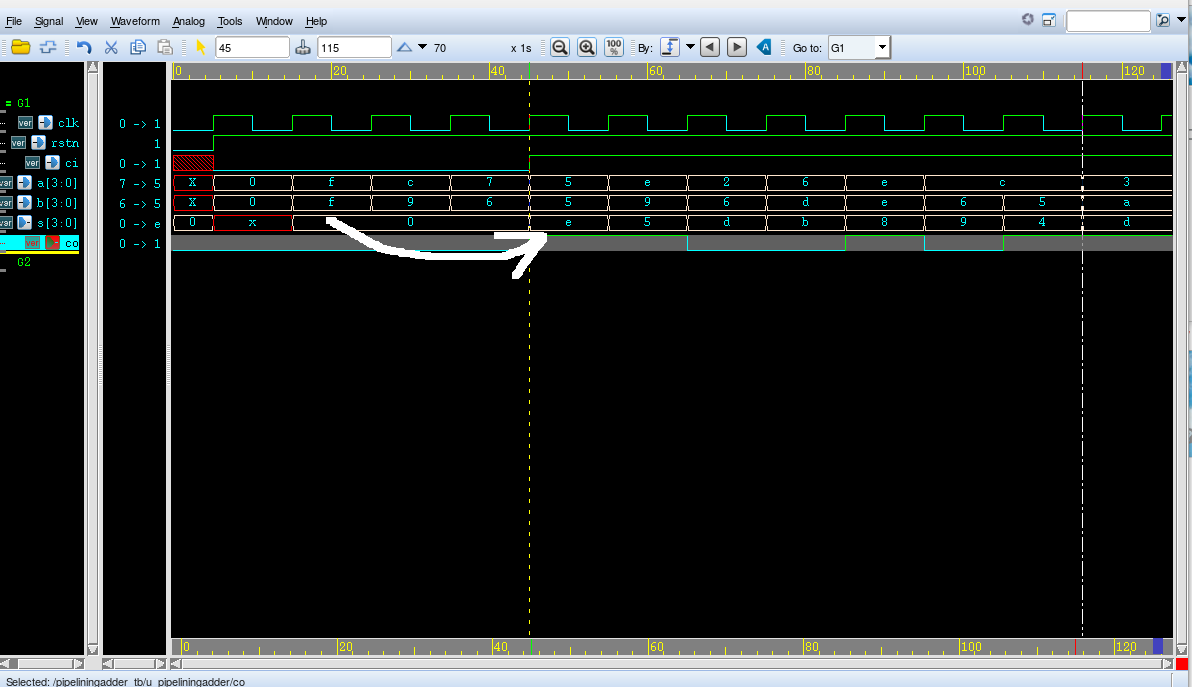- 四位加法器
- 两级加法实现
verilog code
module pipeliningadder(
output reg [3:0] s,
output reg co,
input [3:0] a,
input [3:0] b,
input ci,
input clk,
input rstn
);
reg [3:0] a_tmp;
reg [3:0] b_tmp;
reg [1:0] a_tmp2;
reg [1:0] b_tmp2;
reg ci_tmp;
reg [1:0] s_tmp3;
reg co_low;
reg [1:0] s_low;
reg co_hign;
reg [1:0] s_hign;
always@(posedge clk,negedge rstn)
begin
if(!rstn)
begin
a_tmp <= 4'b0;
b_tmp <= 4'b0;
ci_tmp <= 1'b0;
end
else
begin //将输入的数据缓存起来
a_tmp <= a;
b_tmp <= b;
ci_tmp <= ci;
end
end
always@(posedge clk,negedge rstn)
begin
if(!rstn)
begin
co_low <= 1'b0;
s_low <= 2'b0;
a_tmp2 <= 2'b0;
b_tmp2 <= 2'b0;
end
else
begin //低两位相加,缓存高两位
{co_low,s_low} <= a_tmp[1:0] + b_tmp[1:0] + ci_tmp;
a_tmp2 <= a_tmp[3:2];
b_tmp2 <= b_tmp[3:2];
end
end
always@(posedge clk,negedge rstn)
begin
if(!rstn)
begin
co_hign <= 2'b0;
s_hign <= 2'b0;
end
else
begin //高两位相加及与之间的低两位一并输出
{co_hign,s_hign} <= a_tmp2 + b_tmp2 + co_low;
s_tmp3 <= s_low; //寄存上一级的结果
end
end
always@(posedge clk,negedge rstn)
begin
if(!rstn)
begin
co <= 1'b0;
s <= 4'b0;
end
else
begin
{co,s} = {co_hign,s_hign,s_tmp3}; //合并上两级计算结果,输出结果
end
end
endmodule
testbench
module pipeliningadder_tb;
wire [3:0] s;
wire co;
reg [3:0] a;
reg [3:0] b;
reg ci;
reg clk;
reg rstn;
initial
begin
clk = 0;
rstn = 0;
@(posedge clk) rstn = 1;
a = 4'b0000; b = 4'b0000; ci = 0;
@(posedge clk) a = 4'b1111; b = 4'b1111; ci = 0;
@(posedge clk) a = 4'b1100; b = 4'b1001; ci = 0;
@(posedge clk) a = 4'b0111; b = 4'b0110; ci = 0;
@(posedge clk) a = 4'b0101; b = 4'b0101; ci = 1;
@(posedge clk) a = 4'b1110; b = 4'b1001; ci = 1;
@(posedge clk) a = 4'b0010; b = 4'b0110; ci = 1;
@(posedge clk) a = 4'b0110; b = 4'b1101; ci = 1;
@(posedge clk) a = 4'b1110; b = 4'b1110; ci = 1;
@(posedge clk) a = 4'b1100; b = 4'b0110; ci = 1;
@(posedge clk) a = 4'b1100; b = 4'b0101; ci = 1;
@(posedge clk) a = 4'b0011; b = 4'b1010; ci = 1;
@(posedge clk) $finish;
end
always #5 clk = ~clk;
initial begin
$fsdbDumpfile("test.fsdb");
$fsdbDumpvars();
end
pipeliningadder u_pipeliningadder(
.s(s),
.co(co),
.a(a),
.b(b),
.ci(ci),
.clk(clk),
.rstn(rstn)
);
endmodule
verdi波形查看

总结
使用流水线实现可以缩短关键路径,以提高运算频率,加快运算。
其他相关加法器实现方法:verilog 实现加法器
参考资料
[1]. 加法器的verilog实现